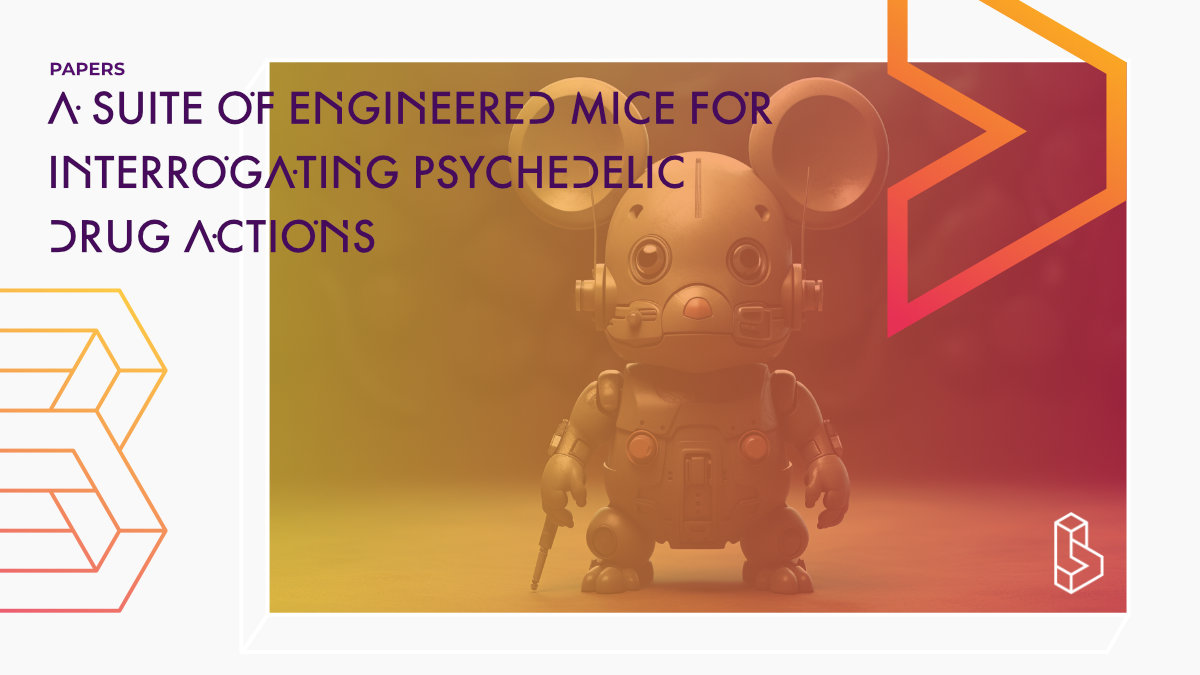This pre-print mice study utilized a suite of engineered mouse models, including Htr2a-EGFP-CT-IRES-CreERT2 mice, humanized Htr2a mice, and constitutive Htr2A-Cre mice, to investigate the role of the 5-hydroxytryptamine 2A receptor (HTR2A) and HTR2A-expressing neurons in the actions of psychedelic drugs such as LSD and psilocybin. These mice exhibited behavioural responses consistent with the known effects of psychedelics, and electrophysiology studies demonstrated an HTR2A-mediated increase in the firing of genetically identified pyramidal neurons.
Abstract of A suite of engineered mice for interrogating psychedelic drug actions
“Psychedelic drugs like lysergic acid diethylamide (LSD) and psilocybin have emerged as potentially transformative therapeutics for many neuropsychiatric diseases, including depression, anxiety, post-traumatic stress disorder, migraine, and cluster headaches. LSD and psilocybin exert their psychedelic effects via activation of the 5-hydroxytryptamine 2A receptor (HTR2A). Here we provide a suite of engineered mice useful for clarifying the role of HTR2A and HTR2A-expressing neurons in psychedelic drug actions. We first generated Htr2a-EGFP-CT-IRES-CreERT2 mice (CT:C-terminus) to independently identify both HTR2A-EGFP-CT receptors and HTR2A-containing cells thereby providing a detailed anatomical map of HTR2A and identifying cell types that express HTR2A. We also generated a humanized Htr2a mouse line and an additional constitutive Htr2A-Cre mouse line. Psychedelics induced a variety of known behavioral changes in our mice validating their utility for behavioral studies. Finally, electrophysiology studies revealed that extracellular 5-HT elicited a HTR2A-mediated robust increase in firing of genetically-identified pyramidal neurons–consistent with a plasma membrane localization and mode of action. These mouse lines represent invaluable tools for elucidating the molecular, cellular, pharmacological, physiological, behavioral, and other actions of psychedelic drugs in vivo.”
Authors: Yi-Ting Chiu, Ariel Y. Deutch, Wei Wang, Gavin P Schmitz, Karen Lu Huang, D. Dewran Kocak, Pierre Llorach, Kasey Bowyer, Bei Liu, Noah Sciaky, Kunjie Hua, Chongguang Chen, Sarah E. Mott, Jesse Niehaus, Jeffrey F. DiBerto, Justin English, Jessica J. Walsh, Grégory Scherrer, Melissa A Herman, Zhuhao Wu, William C. Wetsel & Bryan L. Roth
Summary of A suite of engineered mice for interrogating psychedelic drug actions
Introduction
Serotonin is a biogenic amine neurotransmitter that regulates mood, perception, cognition, pain, feeding, and various other functions in the central nervous system and periphery. It has 14 distinct receptors, most of which are G-protein-coupled.
The 5-hydroxytryptamine 2A receptor (HTR2A) has recently received the most attention, in part due to its apparent involvement in the pathogenesis of several psychiatric disorders and its high affinity for many second-generation (atypical) antipsychotic drugs and many typical and atypical antidepressants.
The HTR2A receptor was first identified by radioligand binding in 1978, was characterized as a membrane protein in 1985, and its encoding gene was cloned in 1988. The sequence of the HTR2A was generally conserved between species.
Find this paper
A suite of engineered mice for interrogating psychedelic drug actions
https://doi.org/10.1101/2023.09.25.559347
Open Access | Google Scholar | Backup | 🕊
Cite this paper (APA)
Chiu, Y. T., Deutch, A., Wang, W., Schmitz, G. P., Huang, K., Kocak, D., ... & Roth, B. L. (2023). A suite of engineered mice for interrogating psychedelic drug actions. bioRxiv, 2023-09.
Study details
Compounds studied
LSD
Psilocybin

